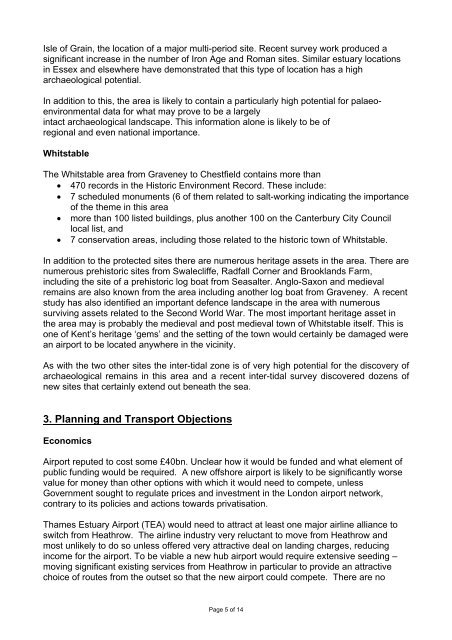1. Ecological objections - London
1. Ecological objections - London
1. Ecological objections - London
Create successful ePaper yourself
Turn your PDF publications into a flip-book with our unique Google optimized e-Paper software.
Isle of Grain, the location of a major multi-period site. Recent survey work produced a<br />
significant increase in the number of Iron Age and Roman sites. Similar estuary locations<br />
in Essex and elsewhere have demonstrated that this type of location has a high<br />
archaeological potential.<br />
In addition to this, the area is likely to contain a particularly high potential for palaeoenvironmental<br />
data for what may prove to be a largely<br />
intact archaeological landscape. This information alone is likely to be of<br />
regional and even national importance.<br />
Whitstable<br />
The Whitstable area from Graveney to Chestfield contains more than<br />
• 470 records in the Historic Environment Record. These include:<br />
• 7 scheduled monuments (6 of them related to salt-working indicating the importance<br />
of the theme in this area<br />
• more than 100 listed buildings, plus another 100 on the Canterbury City Council<br />
local list, and<br />
• 7 conservation areas, including those related to the historic town of Whitstable.<br />
In addition to the protected sites there are numerous heritage assets in the area. There are<br />
numerous prehistoric sites from Swalecliffe, Radfall Corner and Brooklands Farm,<br />
including the site of a prehistoric log boat from Seasalter. Anglo-Saxon and medieval<br />
remains are also known from the area including another log boat from Graveney. A recent<br />
study has also identified an important defence landscape in the area with numerous<br />
surviving assets related to the Second World War. The most important heritage asset in<br />
the area may is probably the medieval and post medieval town of Whitstable itself. This is<br />
one of Kent’s heritage ‘gems’ and the setting of the town would certainly be damaged were<br />
an airport to be located anywhere in the vicinity.<br />
As with the two other sites the inter-tidal zone is of very high potential for the discovery of<br />
archaeological remains in this area and a recent inter-tidal survey discovered dozens of<br />
new sites that certainly extend out beneath the sea.<br />
3. Planning and Transport Objections<br />
Economics<br />
Airport reputed to cost some £40bn. Unclear how it would be funded and what element of<br />
public funding would be required. A new offshore airport is likely to be significantly worse<br />
value for money than other options with which it would need to compete, unless<br />
Government sought to regulate prices and investment in the <strong>London</strong> airport network,<br />
contrary to its policies and actions towards privatisation.<br />
Thames Estuary Airport (TEA) would need to attract at least one major airline alliance to<br />
switch from Heathrow. The airline industry very reluctant to move from Heathrow and<br />
most unlikely to do so unless offered very attractive deal on landing charges, reducing<br />
income for the airport. To be viable a new hub airport would require extensive seeding –<br />
moving significant existing services from Heathrow in particular to provide an attractive<br />
choice of routes from the outset so that the new airport could compete. There are no<br />
Page 5 of 14
















